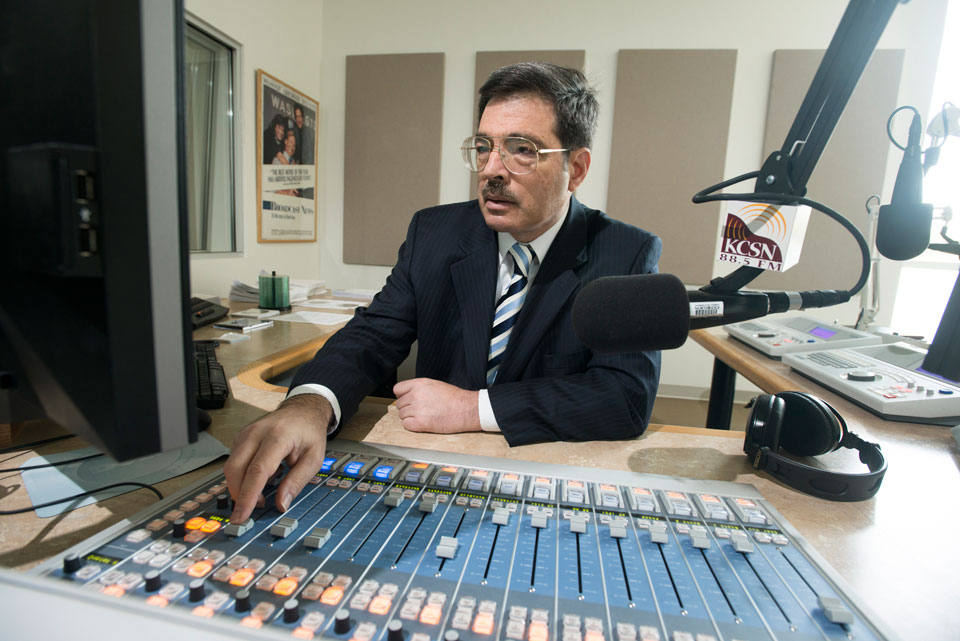Keith Goldstein: A Legacy on the Air
Keith Goldstein, a professor in California State University, Northridge’s Department of Journalism and a guiding force for the news broadcast on the university’s radio station, KCSN-FM 88.5, passed away following complications from influenza May 18 in Woodland Hills. He was 61.
A native of Philadelphia, Goldstein graduated from Temple University and earned his master’s degree at Penn State University, before launching a radio news career that spanned more than three decades. In 1987, while mulling over offers from a university on the East Coast and CSUN, Goldstein chose the San Fernando Valley. At CSUN, he built a legacy through teaching a large number of journalism students who would go on to successful careers in radio and television.
“Keith often referred to himself as an ‘old-school journalist,’ and he devoted his life to teaching our students the all-important foundational skills needed in the workplace,” said Linda Bowen, chair of the journalism department. “Many of his former students can be heard on local and regional broadcast outlets and include those who also teach or have taught in our program.”
CSUN journalism students taught by Goldstein have garnered more than 450 awards that have ranged from local to national distinction. Included in those honors are 50 Golden Mike Awards and 34 Edward R. Murrow Awards from the Radio Television Digital News Association. In April, Goldstein’s students took the top three spots in the Radio Sports Reporting category at the Society of Professional Journalists’ Region 11 Mark of Excellence Awards. The overall winner, Carlos Gonzalez’s report on Narbonne High School football, will be considered for a national award. At the same competition, the KCSN Evening Update was a finalist for the Best All-Around Radio Newscast. During Goldstein’s tenure, his students have received 12 Mark of Excellence Awards.
“Those awards didn’t happen by themselves,” said Rick Marks, a CSUN journalism faculty member. “They happened because of one person, and that’s Keith. It’s a reflection not of him, but his students. But he should be remembered as it being a reflection of him and his teaching.”
Those students who launched broadcast and TV careers after taking Goldstein’s classes have felt the dramatic loss.
“He taught me more about the profession than anyone in school, in terms of how to write, report and produce for broadcast journalism,” said Mike Saeger ’90 (Journalism), the broadcaster for the San Antonio Missions, the San Diego Padres’ Double-A team and an early student of Goldstein’s. “I was clueless going in. I still use stuff today that I learned from him when it comes to writing and producing radio copy and reporting. Most of the same principles apply in play-by-play. I know for certain that he had a profound impact on countless students. Many of those who were part of my class have had successful careers in the field, and Keith was instrumental in that. His legacy will carry on in the body of work of those he shaped.”
In 2015, Goldstein was honored by the Greater Los Angeles Chapter of the Society of Professional Journalists (SPJ-LA) with its Distinguished Journalist Award. This was as much for his career as a radio news journalist as for his work shaping the careers of future radio and TV journalists.
“He was low key,” Marks said. “I never saw him raise his voice. I never saw him get angry. I never saw him get emotional. He was just a real steady individual. He was also a giving person. As a teacher, he was all about his students, and was about his profession. Not just the journalism profession, but the teaching profession. He was the ultimate professor, because he never wavered from what the ultimate mission was.”
“Keith cared about news,” said Jim Hill, a retired journalism faculty member. “He was a professional journalist. He cared about standards. He cared about journalistic values. Most of all, he cared about his students. He truly wanted to give them the best that he could. He was utterly dedicated to that. … We’re going to miss him in many ways at different levels.”
In preparing students for radio news, he also gave them skills that would translate into TV work, said Lincoln Harrison, a CSUN staff member who works in the TV lab and had worked alongside Goldstein since 2003. Teaching broadcast, one becomes a guru for the younger generation, Harrison said, and Goldstein filled that role for 29 years at CSUN. He praised the professor’s “gentleness and his persistence, sensitivity and humanity.”
Goldstein is survived by his daughter, Katy. The university is planning a memorial service to honor the professor, and details are pending. Since his passing, many tributes have filled social media from Goldstein’s colleagues and former students.
CSUN journalism faculty member Sally Turner described Goldstein as a selfless person who made a dramatic impact on the lives of so many he taught.
“He was a shy person. He was very reserved, very formal,” Turner said. “The reason he meant so much to students was he was able to help them with their own nerves, their own fears and help them find their voices. When students are learning, they need someone who understands why it’s difficult. That’s something that was so great about him.
“When you think of the hundreds of students who’ve graduated from our program and are working in radio and television all over the country — and how much he meant to all of them, and how his work lives on through them — I just don’t know how the department will fill that hole,” she said. “He meant a great deal to a lot of people.”




 experience
experience